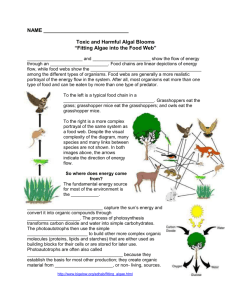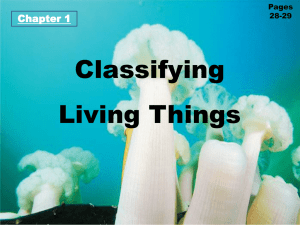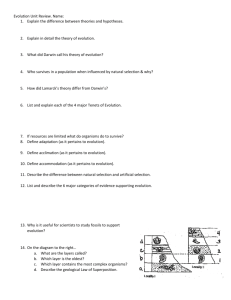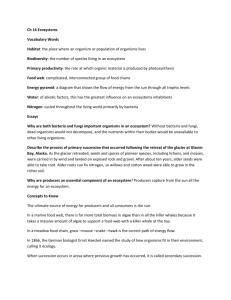Chapter 4: The Biology of Life. Ch 4, 5, 6 TEST Thursday, Oct. 24th 8
advertisement
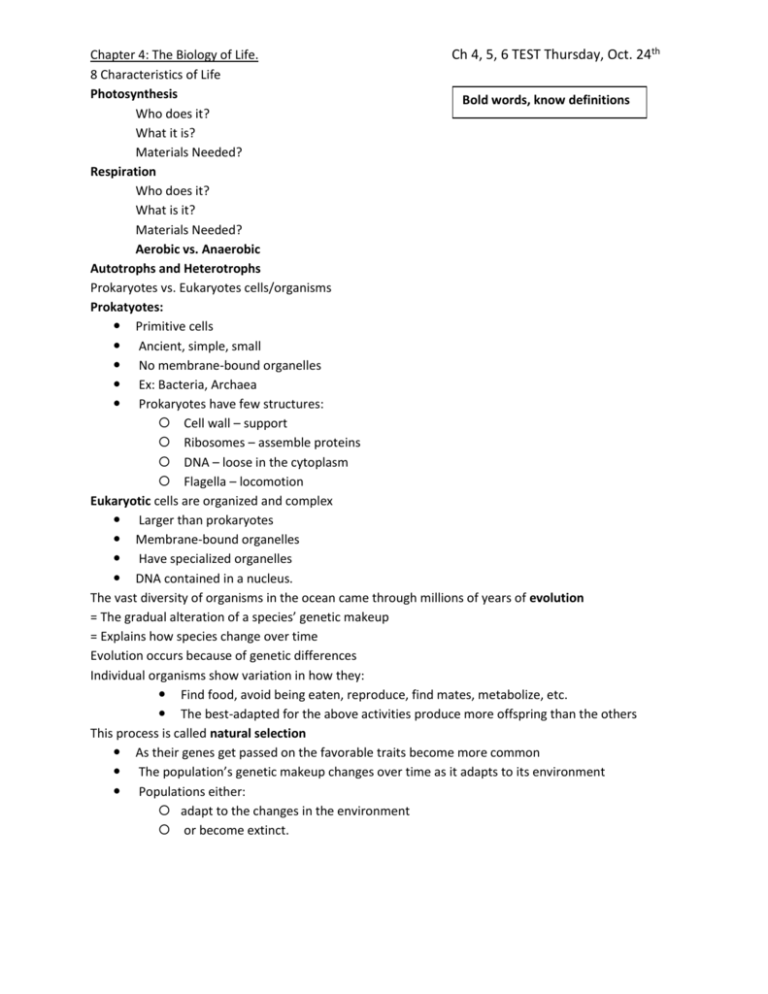
Chapter 4: The Biology of Life. Ch 4, 5, 6 TEST Thursday, Oct. 24th 8 Characteristics of Life Photosynthesis Bold words, know definitions Who does it? What it is? Materials Needed? Respiration Who does it? What is it? Materials Needed? Aerobic vs. Anaerobic Autotrophs and Heterotrophs Prokaryotes vs. Eukaryotes cells/organisms Prokatyotes: Primitive cells Ancient, simple, small No membrane-bound organelles Ex: Bacteria, Archaea Prokaryotes have few structures: Cell wall – support Ribosomes – assemble proteins DNA – loose in the cytoplasm Flagella – locomotion Eukaryotic cells are organized and complex Larger than prokaryotes Membrane-bound organelles Have specialized organelles DNA contained in a nucleus. The vast diversity of organisms in the ocean came through millions of years of evolution = The gradual alteration of a species’ genetic makeup = Explains how species change over time Evolution occurs because of genetic differences Individual organisms show variation in how they: Find food, avoid being eaten, reproduce, find mates, metabolize, etc. The best-adapted for the above activities produce more offspring than the others This process is called natural selection As their genes get passed on the favorable traits become more common The population’s genetic makeup changes over time as it adapts to its environment Populations either: adapt to the changes in the environment or become extinct. Classifying Living Things Species = Binomial Nomenclature. Universal, Latin, Genus species, Italics Ex: Macrocystis pyrifera Organisms are grouped according to their relatedness Related organisms share an evolutionary history, or phylogeny Share a common ancestor What do scientists look at to determine common ancestor? 3 Domains and characteristics of each 1) Domain Bacteria Has 1 kingdom – the Eubacteria 2) Domain Archaea Prokaryotes Contains 1 kingdom – the Archaebacteria 3) Domain Eukarya Includes all kingdoms composed of organisms made up of eukaryotic cells – 4 Kingdoms: Protista, Fungi , Animalia , Plantae Taxonomy = the study of classification and naming living organisms Each grouping is called a Taxon, Taxa plural Kingdoms are divided into groups called phyla Phyla are subdivided into classes Classes are subdivided into orders Orders are subdivided into families Families are divided into genera Genus contain closely related species Species are unique Chapter 5: Microbial World Prokaryotes: “Before nucleus” 2 Domains, 2 Kingdoms: Bacteria and Archaea (more closely related to Eukaryotes) Simplest and oldest life forms Cell wall, cell membranes No membrane bound organelles DNA not in a nucleus Great metabolic diversity Domain Bacteria Most abundant form of life on earth! Ecosystems Importance: Break down organic material into nutrients for other organisms to use Cause diseases in marine animals Phytoplankton blooms Impact on humans: Disease in humans Eukaryotes Food spoilage Respiratory issues, rash. Toxins stored in shellfish, then humans eat it. Other significance of Bacteria Symbiotic Bacteria = associates with other organisms closely. Parasites-harmful Beneficial, Live in a host organism Examples of Beneficial Wood-Digesting Bacteria in wood eating organisms Bioluminescence: attract mates, lure prey, communicate Examples of Parasitic Some toxic Ex of Bacteria: Cyanobacteria Photosynthetic Most abundant photosythetic org. in ocean CYANOBACTERIA and RED TIDE Unpredictable, unsure of cause. Massive blooms of phytoplankton Some toxic By cyanobacteria, dinoflagelletes, diatoms Harms marine life: -cuts fish gills, deplete oxygen levels, some poisonous Harms humans -toxic fumes cause sore throats, respiratory issues, eating marine life that stores these toxins-harmful/deadly Domain Archaea Ancient organisms – fossils found that date back 3.8 billion years Extremophiles – Found in extreme environments like hydrothermal vents and salt flats (two very extreme environments) Variety of metabolic types Widely distributed in the marine community-not all Extremophiles They can tolerate wide ranges in temperature, salinity and even desiccation (drying out) NOW ENTERING DOMAIN EUKARYA… Unicellular Algae Eukaryotes-Protists (some animal-like/some plant-like) Membrane bound organelles = “little organs” Have a nucleus containing DNA Unicellular Cell Wall silicon in diatoms; cellulose in dinoflagellates Most photosynthetic Often animal-like Flagella Some heterotrophic Diatoms Photosynthetic Shell of Silica Most important primary producer on Earth Oxygen And Bottom of the food chain Dinoflagellates Two flagella in grooves on body for motion Shell made of Cellulose Some are bioluminescent, produce light Sometimes cause Red Tide *Zooxanthelle and their relationship with corals. *Ecosystem Significance of Unicellular Algae, Impacts on Humans Protozoans= “First animals” Animal-like Single cell Heterotrophs, ingest food (Some photosynthetic) Found everywhere in oceans 3 main types: Foramaniferans Radiolarians Ciliates Ecosystem Significance of Protozoans/Impact on Humans Chapter 6: Multicellular Producers Multicellular Algae =Seaweeds Eukaryotic Primary producers Not weeds, but algae. Most biologists agree that macrophyte is a much better name, macroalgae too. Lack true leaves, stems, and roots Physical Characteristics: Thallus = the complete body Blade = leaf like, flattened portions Pneumatocysts = gas filled bladders, keep upright so towards sunlight Stipe = stem-like Holdfast = attaches seaweed to a substrate Types of Macroalgae 1) Chlorophyta = Green Have the same pigments as land plants (chlorophyll) More than 7,000 species 2) Phaeophyta = Brown Largest (size) and most complex of the algae Kelps are the largest seaweed we encounter in the ocean. They are also the most complex. Due to this large size, many of the kelps are harvested for food! Example: Giant Brown Kelp, Macrocystis pyrifera -The largest of the kelps. -anchors itself to the sea floor by use a massive holdfast. -extensive pneumatocysts used for buoyancy. -Pneumatocysts keep the seaweed close to the surface to maximize photosynthesis 3) Rhodophyta = Red Most in Marine habitats, 4,000 species. -Substances we get from algae: Algin and carageenan -Know some products made from algae Flowering Plants: Flower, reproductive organ Photosynthetic Eukaryotes True stems, roots, leaves Dominant on Land, few Marine species True Flowering Plants: Seagrasses Salt Tolerant Plants: Salt Marsh grasses Mangroves Seagrasses: Seagrasses have rhizomes, or horizontal stems which grow beneath the sediments Provides habitat for juveniles and larvae of many marine species Anchors sediments Importance of: Helps stabilize soft bottoms Protects coast from turbulence and erosion Salt Marsh Plants: Salt water tolerant species = halophytes Do not tolerate total submergence Act as water purification system Habitat and breeding grounds for many fishery species Protect against erosion Mangroves: Trap and cycle organics, chemical elements, sediment and minerals. Leaf litter important for decomposition, recycling nutrients. Shelter/habitat for marine organisms—often economically important ones. Nearly all commercially/recreationally important fisheries spend a portion of life in mangroves and/or seagrass Stabilize the coastline, reducing erosion from storm surges, currents, waves, and tides. PLANKTON: “drifters, wanderers” Zooplankton (animal-like, Heterotrophs, eat each other and Phyto. ) vs. Phytoplankton (plant-like, autotrophs) Multiple Choice True-False Matching Short Answer/Free Response Ecosystems Significance of Bacteria, Protozoans, Unicellular Algae Ecosystem benefits of Seagrass and Mangroves Euk and Prok differences Autotrophs vs. Heterotrophs List the 7 Taxa Label parts of Seaweed List the 3 types of Protozoans List 3 Domain How are species classified? Define any of the bold faced words
